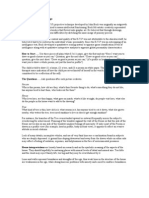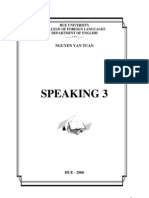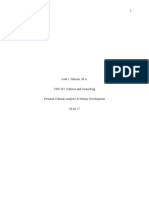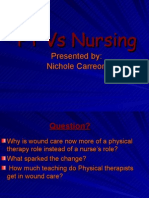Drawing House
Drawing House
Uploaded by
Yong XinCopyright:
Available Formats
Drawing House
Drawing House
Uploaded by
Yong XinCopyright
Available Formats
Share this document
Did you find this document useful?
Is this content inappropriate?
Copyright:
Available Formats
Drawing House
Drawing House
Uploaded by
Yong XinCopyright:
Available Formats
PG Diploma in Play Therapy Manual Section 5 Drawing
HOUSE, TREE, PERSON:
There are two forms of this exercise. In the first, the house, the tree and the person are drawn on
three separate sheets of paper. In the second method, the house, the tree and the person are
drawn on the same sheet of paper.
-to-one relationship
between a specific sign or emotional indicator and a definite personality or trait (Hammer, 1967, 1997;
Koppitz, 1968; Machover, 1952).
Research studies of these variables have shown that anxieties, conflicts or attitudes are often
communicated in the drawings by unique signs and symbols and vary according to client and time
frame. At best, there may be several characteristics that consistently indicate emotional problems
(Malchiodi, 1998). Therefore, meaningful diagnoses cannot and should not be made from a single
sign; rather, the total drawing, as well as combinations of indicators, must always be included when
analysing the drawing.
Additionally, drawings must be interpreted based on chronological age, developmental maturation,
emotional status, social and cultural background, and other relevant history of the individual. For
instance, sketchiness in the line quality has heretofore been viewed as an emotional indicator of
anxiety. Yet, this sketchiness appears to increase with age and is normal for most adolescents, who
Oster and Crone (2004). Using Drawings in Assessment and Therapy (p77)
THE QUESTION
Method Two:
a restrictive way as excluding everything else.
more open way of putting your request. It is clearly much more open and indecisive.
A few questions to ask after the drawing is completed: -
House
Who lives in the house?
Are the people in the house happy?
Do people visit the house?
What else do the people in the house want to add to the drawing?
© Copyright APAC 2015 35
PG Diploma in Play Therapy Manual Section 5 Drawing
Tree
What sort of tree is this?
How old is the tree?
What season of the year is it?
Has anyone ever tried to cut down the tree?
What else grows nearby?
Who takes care of the tree?
I wonder what it would be like to be the tree?
What does the tree see?
Person
Who is the person in the drawing?
How old is the person?
What is their favourite thing to do?
What is something they do not like?
Is the person happy?
Who takes care of them?
Who is their best friend?
Who do they like being with the most?
What is their favourite game?
© Copyright APAC 2015 36
PG Diploma in Play Therapy Manual Section 5 Drawing
What to look for in the drawing:
General
What is the overall feeling you get from the drawing? Is it colourful, joyous, bright or dark,
sad, depressing, angry etc?
Is there a sun or part of a sun in the sky
Are there clouds? - are they light or dark?
Is it raining or stormy?
Are there birds in the sky or in the trees?
Are there animals present who are they?
Are there flowers, bushes, etc. in the garden or in the surroundings?
Are there other people present who are they?
Person
Is the person happy, sad, angry, fearful etc?
Is the person facing towards you, away from you or in profile?
Is the face and/or the body partly hidden?
Is there appropriate interaction of body parts?
Are any body parts particularly exaggerated or highlighted?
Are any of the body parts intensely shaded or scribbled over?
Is the line quality solid or light?
Is the figure clearly defined or almost invisible?
What colour is the clothing?
How large is the figure:
Small size may indicate insecurity and withdrawal or anxiety
Large size may indicate expansive or narcissistic needs.
Are hands and feet present? Are they in proportion to the rest of the body or particularly large?
© Copyright APAC 2015 37
PG Diploma in Play Therapy Manual Section 5 Drawing
General Comments
Missing or oversized facial parts may indicate a denial of the function or malfunction of the missing
oversized parts.
Missing hands or feet suggest a feeling of helplessness or immobility being unable to escape from a
situation.
Feet that are small in proportion to the body may indicate psychological instability.
Large hands or arms may indicate a forceful or aggressive personality. This is considered by some
experts to be a symbolic indicator of possible child abuse.
If the body, particularly the genital region has a large target area drawn on it, child abuse may be a
possibility (Allen, 1992)
House
The house may symbolically represent internal
hostilities, secrecy, enmeshment, openness to outside influences, the level of family protection
given. The house may also indicate the ego strengths and weaknesses, the degree of rigidity of the
personality and the psychological fragility of the child.
When looking at the house, what is your feeling joy, sadness, depression, anger etc.
Is the house solid and grounded?
Is there a chimney?
Bear in mind that many children live in blocks of flats or centrally heated houses in which there is no
chimney.
Is there smoke coming from the chimney?
Is the smoke moderate, suggesting a sense of warmth?
Is the smoke intensely black or red in colour or are there flames coming out of the chimney?
This may be suggestive of tension or conflict in the home.
What is the colour of the house?
Is the house well maintained?
Are there broken or cracked walls, windows?
Are the door/s large, small, open, closed, absent?
© Copyright APAC 2015 38
PG Diploma in Play Therapy Manual Section 5 Drawing
Are there locks or/and bars over the windows and/or doors?
Windows the eyes of the house
Are the windows open, closed?
Are there curtains?
Are there shutters?
Fences are they firm and balanced? Do they identify a clear boundary?
Is the fencing excessive e.g. several layers thick, barbed wire etc?
Are the fences broken?
Is there a gate?
Walls strong or weak and broken?
Roof Solid, broken, or damaged?
Attic Is there an attic (in the roof)? The attic is the place where we store our memories
Path present or absent, open, and inviting, narrow and restricting, broken or damaged?
Tree
general psychological field, the unconscious developmental picture, the psychosexual level and
maturity, contact with reality, and feelings of intrapersonal balance. Drawing a tree supposedly
(Allen, 1992, p152)
environmental trauma, perhaps the loss of a loved one.
his or her
self-being or trying to escape from the dominant person pictured in the drawing. Leaning in the
opposite direction suggests a longing for things to be as they were in the past. A moving tree is
usually associated with a violent force being applied to it from the environment.
within the child. If it is scarred or bent, broken or dead branches, a psychological trauma has usually
occurred sometime in the past. The position of the damage on the trunk is supposedly proportional
disassociated from the canopy, it is a strong indication of intrapersonal conf Allen, 1992, p152)
© Copyright APAC 2015 39
PG Diploma in Play Therapy Manual Section 5 Drawing
The tree may reflect: -
(i) unconscious aspects of the self
(ii) feelings and emotions about the self
(iii) the capacity to obtain support from the environment
(iv) insights into life content and would view
(v) personal characteristics of the drawer
(vi) biographical information
Look at Branches and leaves
The trunk
The roots and grounding
Is the tree grounded, strong, healthy?
Is there fruit on the tree?
Are there birds or animals in the tree?
Are the branches strong and firm or spindly and weak?
Are there sharp spikes?
Is the foliage lush or rather sparse and vaguely drawn?
Are the branches broken?
Is the trunk firm and capable of supporting the tree?
Is the trunk thin and unable to support the branches and leaves?
Is the tree bent, slanted, or curved?
Is the size of the tree appropriate and within context or extremely large or small?
Are the roots solid and supporting? Do the roots suggest stability? Are they deep and strong?
Are the roots shallow and/or spindly or absent altogether?
What are the general surroundings like?
- ugly and bereft of beauty or/and content
- pleasant, inviting and comfortable, safe etc.
A few questions to ask if appropriate
How old is the tree?
Who nurtures the tree?
© Copyright APAC 2015 40
PG Diploma in Play Therapy Manual Section 5 Drawing
What would it be like to be the tree?
What season of the year is it?
Spring anticipation
Summer vitality
Autumn maturity and also the passing of optimal vitality
Winter shutting down
See Liebowitz, 1999, pp 53-69
Some common symbols that may be present:
There are many dictionaries of symbols, which can be useful. Bear in mind, however, that these
books give the generic (universal) meaning and not a meaning, which is unique to the individual
drawer. (See notes on sandplay and the interpretation of symbols).
The Sun
In most cultures the sun symbolically represents masculine energy and power and the moon the
feminine. There are, however, cultures in which the reverse is true.
The sun can be healer, nurturer
supplies the warmth and understanding necessary for development. However, if the sun is setting,
either depression or death in some form may be indicated. A rising sun is usually representative of
-hand
corner of the page), it may indicate a severely impaired farther- (Allen, 1992,
p152)
Rain
Rain may symbolise fertility and spirituality. When children draw rain it usually suggests sadness,
possibly a problem at home. A rainstorm suggests distress.
Clouds
White clouds frequently symbolise purity and the forces of nature, which brings life after drought.
Dark clouds may indicate depression.
Apples
Apples hold the symbolism of love, happiness, death and deception. In fairy tales the apple is half
good and half evil and poisonous.
Birds
White birds may symbolise the soul and transcendence, e.g. Swan, Dove, Goose. Dark birds may
symbolise unconscious negative energies, e.g. Crow, Vulture.
Horse
The horse holds the symbolism of energy, passion, instinct and freedom, e.g. the galloping white
horses. Horses are most frequently drawn by girls around the time of puberty, suggesting the
awakening of their instinctual nature.
Mountains
Mountains are frequently symbols of peace, tranquillity, stillness, eternity, firmness and continuity.
© Copyright APAC 2015 41
PG Diploma in Play Therapy Manual Section 5 Drawing
Fire
Fire holds the symbolism of spirituality, destruction and warmth.
Spirituality purification, renewal, transformation, and passion (Pentecost)
Destruction anger, aggression, destructive passion, hatred (the fires of hell)
For further reading on the House, the Tree and the Person:
Texas: Spring Publications
Bolander (1977). Assessing Personality through Tree Drawings. New York: Basic Books
Koch (1952). The Tree Test. Berne: Hans Huber
Lieberwitz (1999). Interpreting Projective Drawings. Philadelphia: Brunner/Mazel
Oster and Crone (2004). Using Drawings in Assessment and Therapy. New York: Brunner - Routledge
Books on Symbolism:
Becker (1994). The Continuous Encyclopaedia of Symbols. New York: Continuum
Chetwynd (1993) Dictionary of Symbols. London: Aquarian/Thorsons
Cirlot (1995). A Dictionary of Symbols. London: Routledge
© Copyright APAC 2015 42
You might also like
- House Tree Person Interpretation ElementsDocument6 pagesHouse Tree Person Interpretation Elementsnesuma82% (11)
- House Tree Person Brief ManualDocument20 pagesHouse Tree Person Brief ManualAnno Maflo100% (1)
- ESL Brains - Lone Wolf or Social Butterfly - Understanding PersonalitiesDocument17 pagesESL Brains - Lone Wolf or Social Butterfly - Understanding Personalitiesalejandro.16.25.11No ratings yet
- House Tree Person Test ReportDocument17 pagesHouse Tree Person Test ReportKaren Gail Comia100% (3)
- Play Therapy Techniques Through The AgesDocument50 pagesPlay Therapy Techniques Through The Agesanon_19805214680% (10)
- Lesson Plan Template (Task-Based Grammar Lesson)Document4 pagesLesson Plan Template (Task-Based Grammar Lesson)Tika VirginiyaNo ratings yet
- House Tree Person DrawingsDocument20 pagesHouse Tree Person DrawingsAyesha Khalil67% (3)
- House Tree Person DrawingsDocument20 pagesHouse Tree Person DrawingsBushra Awan75% (4)
- House Tree Person DrawingsDocument4 pagesHouse Tree Person Drawingskristychoward100% (1)
- House Tree Person Test ReportDocument18 pagesHouse Tree Person Test ReportKaren Comia100% (2)
- House Tree PersonDocument34 pagesHouse Tree PersonJackylou Blanco100% (2)
- Module 1 BIG FIVE FACTORDocument5 pagesModule 1 BIG FIVE FACTORAnonymous D1mGET2XNo ratings yet
- CBT Case SummaryDocument4 pagesCBT Case SummaryEva GonsherNo ratings yet
- The Performance Wellness SeminarDocument8 pagesThe Performance Wellness SeminarMirelaAlexandraNo ratings yet
- The House Tree PersonDocument8 pagesThe House Tree PersonAzmat ShaheenNo ratings yet
- House-Tree-Person (HTP) TestDocument5 pagesHouse-Tree-Person (HTP) Testattiyaabbasi321No ratings yet
- House Tree Person DrawingsDocument3 pagesHouse Tree Person DrawingsAlvin U. DumdumaNo ratings yet
- General Guidelines For Interpretation-1Document4 pagesGeneral Guidelines For Interpretation-1JaveriaNo ratings yet
- Guidelines For The Interpretations of House Tree Person TestDocument4 pagesGuidelines For The Interpretations of House Tree Person TestCH SamiNo ratings yet
- HTP Interpretations by BuckDocument5 pagesHTP Interpretations by Buckaminaasif1090No ratings yet
- HTP (House-Tree-Person)Document7 pagesHTP (House-Tree-Person)rushnaNo ratings yet
- Ego States and FurtherDocument15 pagesEgo States and Furthermarkayart100% (2)
- HTPDocument15 pagesHTPLilio Carrieda BornalesNo ratings yet
- Drawing Test HTP (House Tree Person Test) : by Muhammad AsimDocument81 pagesDrawing Test HTP (House Tree Person Test) : by Muhammad Asimkomal gulNo ratings yet
- Crisis Toolkit-FinalDocument18 pagesCrisis Toolkit-Finalapi-607387321No ratings yet
- Good Morning Class!: Grade 8 - ManggaDocument22 pagesGood Morning Class!: Grade 8 - ManggaAmalhaya SP MacaangcosNo ratings yet
- INFO Visual LiteracyDocument18 pagesINFO Visual Literacyayavuyancoko14No ratings yet
- DAP Projective Personality TestDocument5 pagesDAP Projective Personality TestDexter LicongNo ratings yet
- TAT FinalDocument12 pagesTAT FinalRiddhima PathakNo ratings yet
- My Child I Want To Know My Child BetterDocument22 pagesMy Child I Want To Know My Child BetterAida IvanNo ratings yet
- Hue University College of Foreign Languages Department of EnglishDocument95 pagesHue University College of Foreign Languages Department of Englishapi-164612470% (1)
- Perceiving Emotions Is About Being Aware of and Sensitive To Others' Emotions. in Other Words, It'sDocument9 pagesPerceiving Emotions Is About Being Aware of and Sensitive To Others' Emotions. in Other Words, It'srasha mostafaNo ratings yet
- Buss Com KahahwkznshanmzDocument29 pagesBuss Com KahahwkznshanmzkhricenkevindemoNo ratings yet
- Trompenaars' 7 Dimensions & Cultural ReconciliationDocument32 pagesTrompenaars' 7 Dimensions & Cultural ReconciliationSyaimma Nur HidayatNo ratings yet
- 2024 CC Mid Term Study GuideDocument4 pages2024 CC Mid Term Study Guidedilashapatel33No ratings yet
- Bestlink College of The PhilippinesDocument14 pagesBestlink College of The PhilippinesJose Sandino E. AnajaoNo ratings yet
- Doodle Analysis and InterpretationDocument12 pagesDoodle Analysis and Interpretationcstocksg1100% (1)
- House Tree Person TestDocument5 pagesHouse Tree Person TestFatima SyedNo ratings yet
- U9 ProjectDocument15 pagesU9 Projectapi-394564312No ratings yet
- Interpretation of The HouseDocument4 pagesInterpretation of The HouseNelson VersozaNo ratings yet
- Adlerian TheoryDocument28 pagesAdlerian TheoryVictoria Dela Pena ManalangNo ratings yet
- BereaveentDocument4 pagesBereaveentellenbulmer3No ratings yet
- 2017 DGB Handout Alsaker Grief Healing RetreatsDocument16 pages2017 DGB Handout Alsaker Grief Healing RetreatssmedjookasanjalicaNo ratings yet
- Anxiety Challenge by Another Name Thesis StatementDocument4 pagesAnxiety Challenge by Another Name Thesis Statementjenniferwatsonmobile100% (2)
- SEES-MODULE-1-4 (Jerimiakenj Cabanizas Answers)Document18 pagesSEES-MODULE-1-4 (Jerimiakenj Cabanizas Answers)Jack FosterNo ratings yet
- HTPDocument3 pagesHTPEmayaNo ratings yet
- Brad Pitt - Merlin ReportDocument18 pagesBrad Pitt - Merlin ReportJamie MckenzieNo ratings yet
- The Bach Flower Remedy Questionnaire: Y e S T e R M GradeDocument3 pagesThe Bach Flower Remedy Questionnaire: Y e S T e R M GradeCosmin100% (2)
- Elements and Principles of Arts in Western andDocument141 pagesElements and Principles of Arts in Western andMichelle EserNo ratings yet
- Alfred AdlerDocument20 pagesAlfred AdlerChristian Arby BantanNo ratings yet
- English Project 1Document23 pagesEnglish Project 1Harsh VashishthaNo ratings yet
- Doodle Analysis and InterpretationDocument12 pagesDoodle Analysis and InterpretationDiah AyuNo ratings yet
- Mental Health Unit: By: Taylor Weaver, Marie Regala, Peggy Leisz, & Maizey MantschDocument12 pagesMental Health Unit: By: Taylor Weaver, Marie Regala, Peggy Leisz, & Maizey MantschTaylorNo ratings yet
- Alfred AdlerDocument20 pagesAlfred AdlerChristian Arby BantanNo ratings yet
- Child and Adolescent GriefDocument8 pagesChild and Adolescent GriefDaciana DumitrescuNo ratings yet
- Ec52a2-Da75-7373-8f77-Aaa351ba81 Conflict 101 - Part 2Document2 pagesEc52a2-Da75-7373-8f77-Aaa351ba81 Conflict 101 - Part 2samehabuzied1No ratings yet
- Mindfulness Based Stress Reduction (MBSR) Program: An OverviewDocument35 pagesMindfulness Based Stress Reduction (MBSR) Program: An OverviewElysa DianaNo ratings yet
- Tyler Model & Taba Model 2.10amDocument9 pagesTyler Model & Taba Model 2.10amlaicisusu71% (7)
- History of Psychotherapy FinalDocument38 pagesHistory of Psychotherapy FinalMarco BonettiNo ratings yet
- Finding A Good TherapistDocument6 pagesFinding A Good TherapistJosephLoarNo ratings yet
- Causes of NPDDocument5 pagesCauses of NPDRhealyn ManuelNo ratings yet
- About 4th Generation NLP - Emergent, Clean FacilitationDocument5 pagesAbout 4th Generation NLP - Emergent, Clean FacilitationViseshNo ratings yet
- Job Description Staff NurseDocument4 pagesJob Description Staff Nursearooba abbasiNo ratings yet
- Copyediting 389 FIXDocument7 pagesCopyediting 389 FIXSri Eka HandayaniNo ratings yet
- Personal Cultural AnalysisDocument12 pagesPersonal Cultural Analysisapi-457706578No ratings yet
- June 2016 MS - Paper 1 Edexcel Psychology AS-levelDocument22 pagesJune 2016 MS - Paper 1 Edexcel Psychology AS-levelmariastvNo ratings yet
- Psychoan Alytic Theory: Barro, Annie Francesca S. BSED31Document11 pagesPsychoan Alytic Theory: Barro, Annie Francesca S. BSED31Annie Francesca BarroNo ratings yet
- Sigmund Freud: Psychoana LysisDocument50 pagesSigmund Freud: Psychoana LysisAbigail Bonifacio GonzalesNo ratings yet
- Mehanizmi Odabrane Kod Zavisnika Od Psihoaktivnih Supstanci Dragana ĐokićDocument14 pagesMehanizmi Odabrane Kod Zavisnika Od Psihoaktivnih Supstanci Dragana ĐokićDragana ĐokićNo ratings yet
- Transfer Kod Poremećaja Ličnosti - Doživljaj Pacijentovog Auto-Ironičnog Prikaza Svoje Povijesti BolestiDocument20 pagesTransfer Kod Poremećaja Ličnosti - Doživljaj Pacijentovog Auto-Ironičnog Prikaza Svoje Povijesti BolestiIva LučićNo ratings yet
- 3ce1dd04 1618830913024Document33 pages3ce1dd04 1618830913024RadhaNo ratings yet
- Wound CareDocument11 pagesWound Carenichole9981No ratings yet
- HMEF5063 Exam Sample SetDocument5 pagesHMEF5063 Exam Sample SetRinkie YeapNo ratings yet
- CAEP Assignment - Rebecca DeatherageDocument8 pagesCAEP Assignment - Rebecca DeatherageBecky DeatherageNo ratings yet
- Save A Warrior - Integrating Evidence-Based Practices For Comprehensive RecoveryDocument2 pagesSave A Warrior - Integrating Evidence-Based Practices For Comprehensive RecoveryjakeNo ratings yet
- Exam4 Psych420Document8 pagesExam4 Psych420denicotienoNo ratings yet
- Presentation About Self-Harm (Dhiyah Mumpuni 1806203654)Document14 pagesPresentation About Self-Harm (Dhiyah Mumpuni 1806203654)DhiyahNo ratings yet
- Magullado, Finals Research and Output in CdiDocument35 pagesMagullado, Finals Research and Output in CdiNovie Jane MagulladoNo ratings yet
- Camacho-Reyes v. ReyesDocument34 pagesCamacho-Reyes v. ReyesDLNo ratings yet
- Graduating Class 2019 - W LetterheadDocument1 pageGraduating Class 2019 - W LetterheadEyadcampanillaNo ratings yet
- GRADES 1 To 12 Daily Lesson LOG I.: Monday Tuesday Wednesday Thursday FridayDocument3 pagesGRADES 1 To 12 Daily Lesson LOG I.: Monday Tuesday Wednesday Thursday FridayAndro Marco AvancenaNo ratings yet
- Introtopsych NotesDocument9 pagesIntrotopsych NotesKylie AnneNo ratings yet
- Psychology Vs Biblical CounselingDocument5 pagesPsychology Vs Biblical CounselingLala GabrielaNo ratings yet

























































































